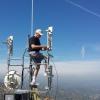Attached is a doc that shows some 802.11ac devices that are appropriate for new installs, or upgrades of existing equipment. While the software for them is still in the nightly builds, the software is stable and they'll be included in the next production release, which should be soon.
All 802.11ac devices:
-
Have Gigabit Ethernet ports, two in some cases, and five for the Mikrotik hAP ac2 & ac3
-
Have faster CPUs
-
Have more RAM
-
Most have more flash memory
-
Appear to have more sensitive receivers
-
Report true noise level
Those of us who have tested 802.11ac devices in production environments are very happy with the improvement in performance. YMMV of course, but I've found with very good link qualities, throughput (as measured with iperf3) can be close to double when both ends have been upgraded.
They report true noise level, rather than the 'fake' -95 dB every 802.11n device shows, regardless of true noise level. Again YMMV but typically I've found the typical noise level to be 5-6 dB better (lower) than -95. While signal strengths don't improve, the lower noise level makes every SNR better :-)
The faster CPU allows for faster web page updates (assuming the network throughput allows it).
Bottom line - don't buy any more 802.11n devices :-)
Enjoy!
73
Orv W6BI


I believe the HAP AC Lite is advertised as an "AC" device, yet I don't believe I have seen any noise readings below -95. Is this unit an exception?
T.D.
Hi, Tom:
The early hAP-ac device did not AREDN link via 5 GHz.
Maybe the ac2 and ac3 can?
73, Chuck
Orv W6BI
Thanks very much for posting 801.11n_Replacements-V1.1.pdf showing compatible replacement units.
On that pdf document, you have the Ubiquiti Powerbeam M5 400 listed as 27 dBi and the Powerbeam M5 620 also listed as 27 dBi. Looking at those units on line, it appears that the 400 is 25 dBi and the 620 is 29 dBi. Let me know if I have that wrong.
Again, thanks for posting the very useful 801.11n replacements document.
73,
John, KM6ZJT
Be aware that they may have different maximum power output (dBm).
300mm dish 22 dBi + 26 dBm = 48 db ERP
400mm dish 25 dBi + 26 dBm = 51 dB ERP
620mm dish 29 dBi + 24 dBm = 53 dB ERP, a lot more $ for 2 dB gain. ;-)
The new 802.11ac similar devices PBE-5AC-??0 devices also may have a maximum dBm split.
300 and 400 mm dishes have 25 dBm
500 and 620 mm dishes have 24 dBm.
An upgrade from the 400mm to 500mm dish is only 1 dB ERP.
Be aware.
73, Chuck